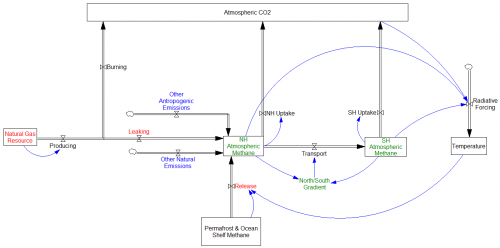RealClimate has a nice summary of recent atmospheric methane findings. Here’s the structure:
 The bad news (red) has been that methane release from permafrost and clathrates on the continental shelf appears to be significant. At the same time, methane release from natural gas seems to be larger than previously thought, and (partly for the same reason – fracking) gas resources appear to be larger. Both put upward pressure on atmospheric methane.
The bad news (red) has been that methane release from permafrost and clathrates on the continental shelf appears to be significant. At the same time, methane release from natural gas seems to be larger than previously thought, and (partly for the same reason – fracking) gas resources appear to be larger. Both put upward pressure on atmospheric methane.
However, there are some constraints as well. The methane budget must be consistent with observations of atmospheric concentrations and gradients (green). Therefore, if one source is thought to be bigger, it must be the case historically that other natural or anthropogenic sources are smaller (or perhaps uptake is faster) by an offsetting amount (blue).
This bad-news-good-news story does not rule out positive feedbacks from temperature or atmospheric chemistry, but at least we’re not cooked yet.
